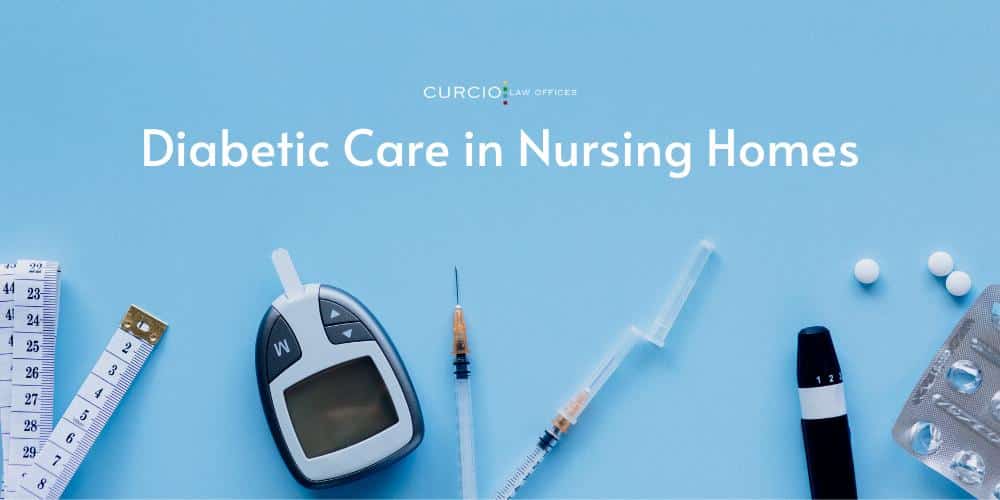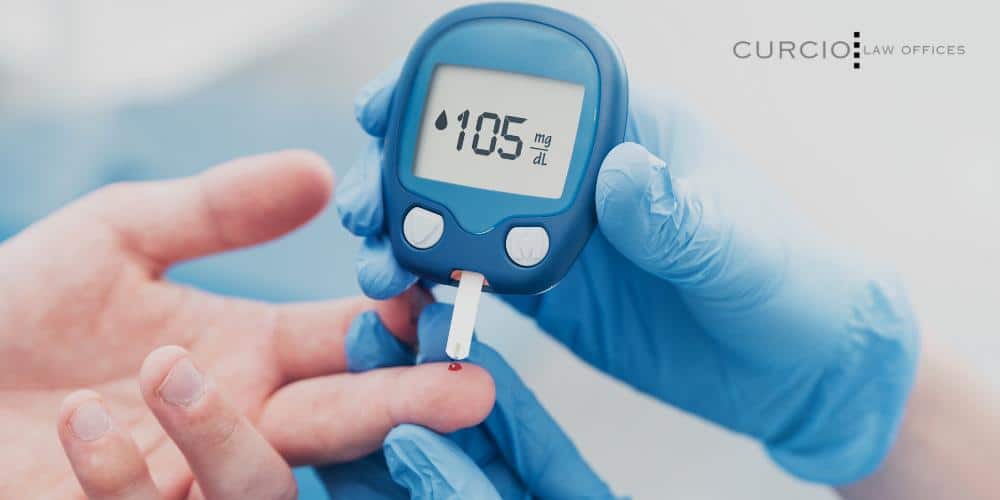CHICAGO NURSING HOME DIABETES LAWYER
PRACTICE AREAS
Nursing Care Plans for Diabetic Patients
Diabetes mellitus is a common disease that afflicts Americans of all ages. It is very possible to manage diabetes and live an incredibly normal life. Mismanaged diabetes, on the other hand, can be extremely disabling and even deadly. Elderly people have a higher risk of developing diabetes and suffering from the deadly complications associated with the disease.
That’s why it’s crucial for long-term care facilities to implement nursing care plans for diabetic patients. If a nursing home fails to properly treat a diabetic patient – and they suffer major health complications and/or death as a result – loved ones have grounds to sue the nursing home for negligence.
If your elderly loved one has suffered major disability or death in their nursing home due to poor diabetes care, you need strong legal representation on your side. Curcio & Casciato is a top Chicago elder abuse law firm. We have the skill and experience to obtain justice and compensation for your loved one’s suffering. Call 312-321-1111 to schedule a free consultation with our Chicago nursing home abuse lawyer today.

What is Diabetes?
Diabetes (AKA diabetes mellitus) is a disease that causes a person to constantly have high blood sugar. This happens when the pancreas doesn’t produce enough insulin or the body doesn’t utilize insulin as well as it should.
So when you eat food, your body turns a lot of it into sugar (glucose), which turns into energy. This glucose is released into the bloodstream, triggering insulin production from the pancreas. You need insulin – which is a hormone – to turn sugar into energy. This happens when insulin allows sugar to enter the cells of the body. As a result, blood glucose levels naturally drop.
If you have diabetes, you will either suffer from insulin resistance or just a complete lack of insulin production. So your blood sugar will stay elevated because insulin will not be turning glucose into energy.
Normal blood glucose levels are 99 mg/dL or lower while fasting according to the Centers for Disease Control (CDC). 100 to 125 mg/dL indicates that you may have prediabetes. A fasting blood glucose level of 126 mg/dL or higher indicates that you have diabetes. So the main goal with diabetes is blood glucose control. You want to keep your blood glucose levels within a normal range, and you can do so with insulin therapy and lifestyle changes.
With proper diabetes education and a solid treatment plan, diabetes is a very manageable disease. Long-term, elevated blood glucose levels can certainly result in major complications and even death.
Types of Diabetes
There are several types of diabetes, including:
- Prediabetes: Someone may have prediabetes if their fasting blood glucose levels are elevated, but not elevated enough to fall within the diabetes range. The CDC claims that approximately 96 million American adults are prediabetic.
- Type 1 Diabetes Mellitus: Only about 5 to 10% of diabetes sufferers have type 1, according to the Centers for Disease Control (CDC). Many medical experts believe that type 1 diabetes may be caused by genetic and/or autoimmune reactions, which is when the body attacks itself. As a result, the pancreas produces little to no insulin. Children, teens, and young adults typically suffer from type 1 diabetes.
- Type 2 Diabetes Mellitus: Approximately 90 to 95% of all diabetes sufferers have type 2 diabetes according to the CDC. Similarly to type 1, sufferers struggle with constant high blood sugar. Type 2 diabetes mellitus typically develops over the course of several years (mostly due to poor lifestyle choices), so most people who have it are well into adulthood.
- Gestational Diabetes only occurs during pregnancy, and typically resolves immediately after birth. Women who develop gestational diabetes have a higher risk of developing type 2 diabetes mellitus later in life. Additionally, their babies have a higher risk of suffering from childhood obesity and type 2 diabetes. Proper diabetes care during pregnancy can prevent most negative health issues. Additionally, ensuring that the child eats a healthy diet and gets plenty of activity can prevent later development of type 2 diabetes mellitus.
How Many Americans Have Diabetes?
According to the American Diabetes Association (ADA), 1.4 million Americans receive a diabetes mellitus diagnosis every year. In 2019, more than 37 million Americans had diabetes – the majority of those people (approximately 35 million) suffering from type 2 diabetes mellitus.
Elderly people (ages 65 and older) typically make up a large percentage of annual diabetes sufferers in the United States. In fact, the American Diabetes Association claims that seniors make up almost 30% of all diabetes diagnoses. Considering that there are about 1.3 million seniors residing in U.S. nursing homes – and many of these nursing homes abuse and neglect their residents somehow – it’s crucial for all facilities to have solid nursing care plans for diabetic patients.
What Causes Diabetes?
Medical experts are unsure what causes type 1 diabetes mellitus. Many theorize that genetics or an autoimmune reaction causes the disease. Risk factors for type 1 diabetes include having autoantibodies and having family members with diabetes. Meanwhile, type 2 diabetes mellitus is generally the result of an unhealthy lifestyle. Risk factors for developing type 2 diabetes include:
- Having a body mass index above 25
- Being inactive every day
- Overindulging in fast food and sugary foods for several years
- Having family members with type 2 diabetes
- Being over the age of 45 years old
- Being prediabetic
- Having gestational diabetes
- Having non-alcoholic fatty liver disease
Diabetes Symptoms
The type and severity of diabetes symptoms generally depends on how high your blood glucose levels are. Some people, especially those with prediabetes, may not have symptoms at all. Others generally experience many of the following types of symptoms:
- Excessive thirst
- Excessive peeing
- Unintentional weight loss
- Excessive hunger
- Ketones in urine
- Fatigue
- Weakness
- Blurred vision
- Increased irritability and general mood swings
- Cuts and sores that heal slowly
- Frequent infections such as skin infections, gum infections, vaginal infections, etc.
- Numbness and/or tingling in the hands or feet
- Very dry and flaky skin
Diabetes Treatment
Managing diabetes can be really easy, especially with good medical care.
The goal with all types of diabetes is to keep the blood glucose levels within a normal range. This can be done through insulin therapy, oral medications, and nutritional therapy.
People with both type 1 and type 2 diabetes must do frequent blood glucose monitoring. This often means that they prick their fingers one or more times a day and check their blood glucose levels with portable blood glucose meters (AKA glucometers). People with type 1 diabetes generally have to check their blood glucose levels multiple times a day, while people with type 2 diabetes generally check it much less often. That’s because people with type 1 diabetes often need insulin injections or insulin pump therapy. Some people with type 1 may even need continuous subcutaneous insulin infusion. On the other hand, not all people with type 2 diabetes need to follow an insulin regimen, because many can manage their disease with good health habits and oral drugs.
A big part of diabetes care is following a healthy lifestyle. This means monitoring the daily amount of carbohydrate consumed, following an exercise regimen, and limiting alcohol in order to control glucose levels. Additionally, many doctors recommend weight loss for overweight diabetic patients.
Another important part of diabetic care is undergoing regular A1C testing, which measures average blood glucose levels over the past few months. A1C testing provides doctors with insight about how well their current patient’s diabetic care plan is working. If A1C levels come back high, then the healthcare provider will likely alter insulin dose, lifestyle habits, and oral medications.
Diabetes Complications
Poor diabetic care can result in disabling and/or life-threatening complications, such as:
- Cardiovascular disease such as coronary artery disease, atherosclerosis, heart attack, etc.
- Peripheral neuropathy, which occurs when long-term unstable blood glucose levels damage the blood vessels that feed nerves
- Kidney damage
- Diabetic retinopathy, which is eye damage caused by diabetes
- Depression
- Alzheimer’s disease (type 2 diabetes, in particular, can raise the risk of neurological conditions)
- Chronic skin infections
- Gangrene which is when tissue dies due to infection or lack of blood flow
- Amputation of the fingers, toes, or feet often due to gangrene
- Diabetic ketoacidosis, which occurs when the body creates too many ketones
- Death

How Nursing Homes Should Care for Diabetic Patients in Chicago, IL
Because so many American seniors suffer from diabetes, long-term care facilities must have solid nursing care plans for diabetic patients. So many nursing home residents with chronic conditions and diseases – not just diabetes – are abused and neglected daily.
Generally, nursing home abuse and neglect occur due to a combination of Chicago nursing home understaffing and poor training. As a result, diabetic nursing home residents may not receive the medical care they desperately need. This is a dangerous situation that can easily lead to major health complications and/or death. If your loved one died due to diabetic or hypoglycemia complications in an Illinois nursing home, our Chicago nursing home wrongful death lawyers can help you pursue damages.
A typical care plan for diabetes in nursing homes may look like this:
- Daily blood glucose monitoring.
- Daily insulin injections and/or medications specifically for diabetic control.
- Nutrition therapy: limited carbohydrates, limited calories, high protein, lots of vegetables, etc.
- Daily physical activity, as long as the patient has no other health conditions that affect their mobility.
- Regular A1C testing.
Elderly people have a higher risk of developing severe complications related to diabetes. So, nursing home staff must prioritize optimum diabetes management. And if residents do develop complications, then nursing staff must act quickly. If your loved one didn’t receive the proper nutrition, contact our Chicago nursing home malnutrition lawyers for more information.
Is Poor Diabetic Care in Nursing Homes a Sign of Abuse and Neglect?
Yes, poor diabetes management in nursing homes is definitely a sign of nursing home abuse and neglect. Diabetes is a disease that needs constant attention. Diabetic people of any age can suffer life-threatening health complications if they fail to control blood sugar levels for too long. However, these health complications can be much more deadly for elderly people with diabetes. If your loved one’s long-term care facility has failed to implement nursing care plans for diabetic patients, then you can take legal action.
What are the Consequences of Poor Diabetic Care in Nursing Homes?
Poor diabetes care in nursing homes can result in a wide variety of health complications, such as heart problems, eye damage, kidney damage, nerve damage, gangrene, amputations, skin infections, and even death. All long-term care facilities must implement a variety of nursing interventions in order to prevent these complications. Our Chicago nursing home infections lawyers have extensive experience with various types of infections due to a lack of antibiotic stewardship and nursing home abuse.
Can I Sue a Nursing Home for Hypoglycemia Complications in Illinois?
Yes, you can sue if your elderly loved one has suffered major health consequences and/or death in their nursing home. For example, if your elderly loved one’s nursing home failed to do regular blood glucose checks and/or administer insulin every day – and the loved one suffered major kidney damage as a result – you could certainly sue the nursing home for negligence. Additionally you could sue if the nursing home failed to promptly treat an elderly patient’s complications from diabetes.
If the nursing home’s failure to follow a care plan for diabetes resulted in patient death, then you have grounds to file a wrongful death claim on your loved one’s behalf.
Chicago medical malpractice lawyers at Curcio & Casciato can analyze the details of your case and help you seek compensation either through a nursing home negligence lawsuit or a wrongful death lawsuit.

Chicago Nursing Home Abuse Lawyer for Hypoglycemia Complications
Nursing homes are required by law to promote patient safety, health, and wellbeing. Failing to implement nursing care plans for diabetic patients is a blatant example of nursing home negligence. The legal team at Curcio & Casciato understands how deadly diabetes can be, especially for elderly people. We want to fight for the justice of all mistreated nursing home residents, and we have the skill and experience to do so. Call 312-321-1111 to schedule a free consultation at our law firm today.


